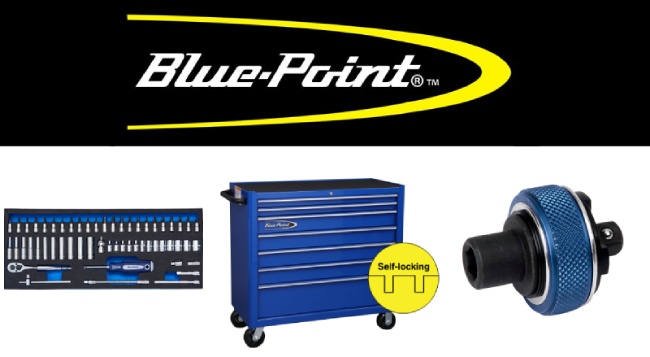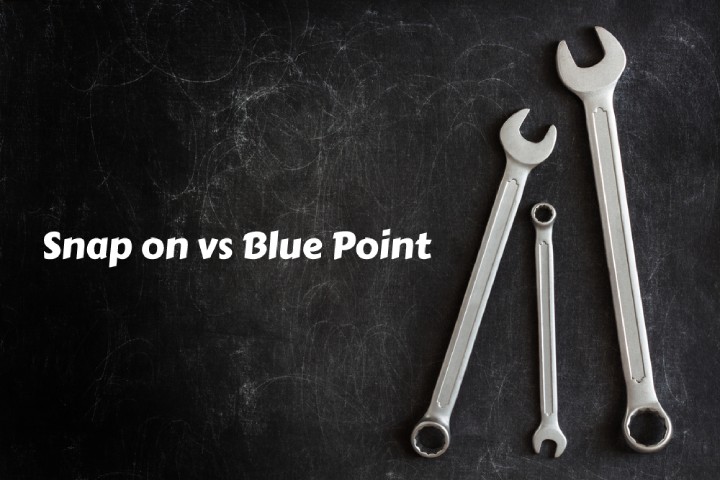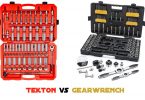If you are thinking about which tool brand to buy, it is important to know the differences between Snap-on and Blue Point tools.
This will allow you to know which is best suited for the job you need to do, which comes at a higher price and their features.
What is the difference, and which is better? We discuss those questions below.
What Are Snap-on Tools?

Snap-On is a tool designer, manufacturer, and distributor company that supplies high-end equipment and tools for professional use. They mainly produce tools for the automotive sector, but you will also find tools for other implications.
Snap-On is an American brand that has manufacturing plants all over the United States. According to many users, Snap-on provides the best quality tools and equipment across the entire globe.
Perhaps what amazes its users the most is the lifetime warranty Snap-on provides with most of its tools. Users take this as a commitment to quality and as a result, Snap-on has become one of the largest tool manufacturers in the world.
The only negative side of Snap-On tools is they are the most expensive ones on the market. However, most of the users have little or no complaints as they can rely on the quality Snap-on provides.
What Are Blue Point Tools?

Blue Point is a 90-year-old brand that started its journey in Wisconsin, United States. Snap-on distributes tools made by Blue Point across the country. The tools have the same specifications as Snap-on tools but come with a different finish.
As a result, many people think that Blue Point tools are the cheaper, lower-end version of Snap-On products. Despite being a bit inferior in quality, Blue Point tools are capable enough to get your day-to-day, normal jobs done.
The tools are sturdy and durable, and they also provide a lifetime warranty with most of their products. You’ll find no issue using Blue Point tools for common jobs, but they aren’t intended for professional use. Aside from Snap-on, Blue Point also uses other manufacturers across the globe.
Differences Between Snap-on and Blue Point Tools
-
Materials
There are several materials that are utilized in Snap-on tools. Metal, plastic, rubber, and wood are the most frequent.
Each material has unique features that make it more suited for certain activities. Metal, for example, is a strong and durable material that is ideal for heavy-duty jobs like drilling.
Blue Point Tools are defined by the materials used to create them. Many different materials are employed in the manufacture of these tools.
Ranging from steel, cobalt chrome and carbon spring steel. Some tool groups employ more than one material for an object, while others use just one material throughout.
-
Quality
The quality and accuracy of both goods are excellent. On the other hand, Snap-on claims that its tools are more durable than Blue Point’s because they are made of thicker metal. Similarly, it is warranted never to damage or wear out.
In contrast to other manufacturers, Snap-on provides a lifetime warranty. Furthermore, Blue Point tools haven’t had the same level of quality as Snap-on tools.
A variety of producers created this brand, so anticipate some inconsistencies in quality. As a result, Snap-on beats Blue Point in this category.
-
Product Line
Snap-on Tools Wrenches are widely used in the United States. Some of their most popular products are screwdrivers, ratchets, tool storage in roll cabs, and sandblasters.
Similarly, Blue Point tools include wrenches, box-end wrenches, open-end wrenches, supreme or wrenches, tappet wrenches, brake and ignition, water-pump wrenches, and combination wrenches, sander, angle drill, ile set, punch set, scraper set, pliers, hammers, impact socket set, screwdriver set and drive socket set.
-
Use of Tools
Snap-on Tools are prevalent in the construction industry. They help people in the field with their work. It has become increasingly important to use them since they are highly efficient.
Meanwhile, Blue Point manufactures tools that are less durable and less expensive than Snap-on. So, these are normally used for comparatively light work.
-
Price Range
As Snap-on tools are more costly than Blue Point tools, you should consider the degree of quality they give. They also have a long lifespan due to their high build quality and compact frames.
Snap-on promotions and discounts may help you locate excellent deals. Some are more persuading than others, so you could end yourself acquiring some high-quality things at a bargain.
Blue Point provides various reasonable quality items at affordable prices, so you don’t have to sacrifice quality to save money.
Product Line Comparison
-
Wrench Set
Snap-on wrenches are a type of wrench with a ratchet head. The ratchet head also has a mechanism that lets the user disengage the tool from the socket or nut by pressing a button at one end.
Blue Point wrench is a type of adjustable wrench, which has a similar structure as Snap-on, but it’s not as sophisticated as its counterpart. For example, it has only one ratchet gear for quick engagement and disengagement from sockets and nuts.
The two toolsets differ in their design and usage, but they both have similar functions because they are both used for loosening or tightening bolts or screws that aren’t conical in shape.
-
Screwdriver Set
The Blue Point screwdriver with the serrated blade is ideal for working on electronics. With its smooth, round blade, the Snap-on is best for woodworking, home repairs, and other jobs that require a lot of leverage.
-
Drive Socket Set
The Blue Point Socket Set and the Snap-on Socket Sets both offer a wide range to choose from. However, the Snap-on used to be favored for its durability and longevity.
Blue Point tends to be lighter and easier to manage than Snap-on socket sets unfortunately Blue Point doesn’t offer as many options in terms of length and size as the Snap-on does.
-
Impact Socket Set
Snap-on impact socket sets are made up of a thin shell that can easily be slid into a rotational head on a wrench. Blue Point sockets set is made out of an impact-resistant plastic sleeve with interchangeable hexagonal bits.
-
Double Box Wrench Set
The Blue Point double box wrench set is a tool that comes with a range of functions. It can be used for different tasks, from tightening bolts to loosening them.
The difference between the two tools is that the Snap-on wrench relies on rotating handles, while the Blue Point wrench has sliding handles. The advantage of having a sliding handle is that it will not get stuck when loosening or tightening bolts, making it more practical in certain situations.
-
L-Shaped Wrench Set
The Snap-on vs. Blue Point L-Shaped Wrench Sets are two different tools that get used for different purposes. The Snap-on is a tool used to tighten nuts or bolts or loosen them to free them up. The Blue Point wrench set is used in the construction industry to drive in screws.
Snap-on wrench sets are also referred to as “speed wrenches” because they can be easily tightened and loosened, making this type of wrench set applicable for quick work on a vehicle or machine you’re working on.
A Blue Point l shaped wrench set is a general-purpose tool that’s easy to use and ideal for daily use, especially when working with wood, metal, plastic, etc.
-
Pliers Set
Blue Point Pliers are designed for general use with a focus on durability and long-term use. They come in various sizes, from small to large, with bright colors that make them easy to spot during everyday tasks.
Snap-on Pliers work for specific functions like gripping and cutting wires or taking off rivets and fasteners. They come in various sizes, from small to large, with no color variations because the gripping action creates an audible click when it occurs.
-
Punch Set
A “Blue Point” punch set is used for the general construction of items. The Blue Point punches are smaller in size but have a wide range of uses. A “Snap-on” punch set is made for precise tasks, such as creating hole patterns or creating material that can be finished with rivets.
The distinction between the two types of punch sets is the difference between specific and general use.
-
Scraper Set
A Snap-on scraper is a device that will break the seal on paint cans and leave no markings on the can. A Blue Point scraper does not spread out the point but instead is used to make tiny scratches in order to scrape up old paint.
-
Torque Wrench
Blue Point Torque Wrench is accurate enough to use as long as the span between the wrench head and handle stays at around 2 inches. It can also be used as a regular wrench as it is not as heavy as other wrenches.
Snap-on Torque Wrench has been designed for mechanics and repair professionals who require high-performance tools with greater accuracy. The manufacturer guarantees that this product will deliver accuracy within one-tenth of a pound because of its design and materials used in manufacturing.
-
Angle Drill
The difference between a Snap-on and a Blue Point angle drill is that the latter is not powered by an electric motor. A Blue Point drill uses a belt and pulley system to power the bit rather than an electric motor.
The Blue Point angle drill has a wider base that is used for drilling into concrete or concrete block, while the Snap-on has a smaller base that is typically used in wood.
-
Sander
A Snap-on sander is a tool that helps in loosening and removing material from surfaces such as wood, tile, and metal while a Blue Point sander is designed for finishing surfaces. A Blue Point sander has an ergonomic handle while the handle of Snap-on sanders is not designed ergonomically. Bluepoint sanders also have rotating heads which can be used for tasks like sawing while Snap-on sanders do not have rotating heads.
-
Hammers
Blue Point Hammer is a compact and lightweight hammer that has a long and narrow head. It has a curved head that can easily fit into tight spaces. The round handle makes it comfortable to hold, but it can be difficult to keep a firm grip on the tool while using it.
Snap-on Hammer is designed for use by carpenters, mechanics, and other professionals who need tools for precision work. It has an ergonomic handle that allows users to exert more force without straining their wrists or hands. The head of this tool is made from hardened steel for durability.
-
File Set
Snap-on and Blue Point file sets come in different sizes that can hold a variety of different tools. They both have a wide range of colors that allow you to easily identify each tool.
The Blue Point File Set is a Snap-on set that comes in three sizes – 1, 2, and 3. It has 10 compartments in total and four compartments in each size with their own individual locking mesh pockets to store small items like screws and drill bits.
-
Impact Wrench
A Snap-on impact wrench is a wrench where the ratchet is attached to a plastic or metal ring that can be threaded onto the hexagonal socket. Snap-on wrenches have a quick-release mechanism so they can be removed from the nut without having to loosen it with a screwdriver.
A Blue Point impact wrench has a square shape rather than hexagonal. It features an offset handle that makes it easier to get into tight spaces and still provides good leverage. The tool comes with an adjustable spanner that allows for easy adjustment on multiple nuts.
Snap-on Tools – Pros & Cons
Pros
1. Recognized as Leading Global Manufacturers
Snap-on tools are leading the manufacturing and distribution of tools and tool accessories globally. This is due to their high-quality craftsmanship.
2. Durable Products
Snap-on offers very high quality in their tools. If you are handling heavy-duty jobs that require high-pressure levels, these tools are durable enough.
3. Lifetime Warranty
You get a lifetime warranty for as long as the tool is yours for hand tools and storage units. For power tools, brand meters, and diagnostic items, you get a one-year warranty only.
Cons
1. High Price Tag
Unfortunately, due to the quality and manufaftoruin process, the Snap-on tools come with a high price tag, but they last longer. This means you are replacing it less often.
Blue Point Tools – Pros & Cons
Pros
1. Good For Basic Functions
Blue Point tools are good for basic jobs but don’t really handle complex jobs. Jobs like a mechanic would be handling would find the tools don’t hold up as well.
2. Less Pricey
These tools are cheaper to buy. However, they cannot reach the quality of the other brand, but they do come with a lifetime warranty.
Cons
1. Bulkier Than Snap-on
Professionals prefer to deal with a slim tool as it is easy to hold and handle. Blue Point tools are bulkier than Snap-on tools.
2. May Not Fit In Tight Spots
Due to this brand using bulkier items, it can be hard to get them into hard-to-reach places and tight nooks and crannies.
Which of the Two Brands Should You Choose?
Snap-on has the best quality going. Unfortunately, they have the highest price tag.
Snap-on is a signature brand. Blue Point comes in second with the tasks it can handle, quality, and durability.
It will depend on what you are using the tools for, how complex the work is and what price you are willing to pay.
FAQs
1. Why Is Snap-on Called Snap-on?
Ans. The tools are called Snap-on due to their interchangeable wrench heads. They just Snap-onto a huge variety of tool handles.
2. Why is Snap-on So Expensive?
Ans. Snap-on tools are pro-level tools. Each is made with better quality and materials and is designed to last. These tools are made in smaller batches which are pricer than bulk-made tools.
3. Can I Return Snap-on Tools?
Ans. You can return the item that you brought within 30 days of when it was delivered.










Leave a Comment